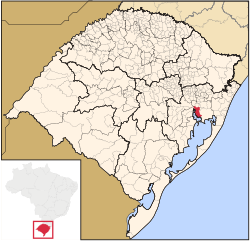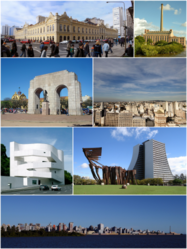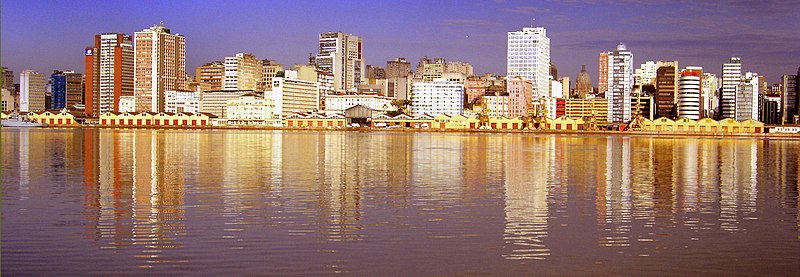Porto Alegre
| Município de Porto Alegre "Capital dos Gaúchos"
Porto Alegre
"Poa" |
|||
|---|---|---|---|
|
Image montage Porto Alegre
|
|||
|
|
|||
| Coordinates | 30 ° 2 ′ S , 51 ° 12 ′ W | ||
 Location of the municipality in the state of Rio Grande do Sul Location of the municipality in the state of Rio Grande do Sul
|
|||
| Symbols | |||
|
|||
| founding | March 26, 1772 (foundation) (age 248) December 11, 1810 (emancipation) (age 208) |
||
| Basic data | |||
| Country | Brazil | ||
| State | Rio Grande do Sul | ||
| ISO 3166-2 | BR-RS | ||
| Metropolitan area | Porto Alegre | ||
| height | 10 m | ||
| Waters | Lake Guaíba | ||
| climate | subtropical mild, Cfa | ||
| surface | 495.4 km² | ||
| Residents | 1,409,351 (2010) | ||
| density | 2,844.9 Ew. / km² | ||
| estimate | 1,483,771 (July 1, 2019) | ||
| Parish code | IBGE : 4314902 | ||
| Post Code | 90000-000 to 91999-999 | ||
| Telephone code | (+55) 51 | ||
| Time zone | UTC −3 | ||
| Website | portoalegre.rs (Brazilian Portuguese) | ||
| politics | |||
| City Prefect | Nelson Marchezan Júnior (2017-2020) | ||
| Political party | PSDB | ||
| Culture | |||
| City festival | March 26 (foundation) | ||
| economy | |||
| GDP | 73,425,264 thousand R $ 49,578 R $ per person (2016) |
||
| HDI | 0.805 (very high) (2010) | ||
|
Aerial view of the center
|
|||
Porto Alegre ([ ˈpoɾtu aˈlɛɡɾi ] / German 'Freudiger Hafen'; officially Portuguese Município de Porto Alegre ) is the capital of the Brazilian state of Rio Grande do Sul . It is one of the largest cities in Brazil and an economic and cultural center of the southern part of the country. Porto Alegre has 81 neighborhoods ( Bairros ).
geography
location
The city has a large river port and is located at the confluence of several medium-sized rivers that flow into the Rio Guaíba . This is lagoon-like wide and merges into the 250 kilometers long and up to 60 kilometers wide Lagoa dos Patos .
According to the IBGE estimate of July 1, 2019, Porto Alegre has 1,483,771 inhabitants and is ten meters above sea level. The entire metropolitan area of Porto Alegre comprises more than 30 cities (including Canoas , Novo Hamburgo , São Leopoldo and Gravataí ) and counted 4,317,508 people on July 1, 2018. Due to its location in the extreme south of the country, the city is further away from major Brazilian cities such as Rio de Janeiro (distance 1558 km), São Paulo (1109 km) and the capital Brasília (2027 km) than, for example, from Montevideo , the capital of Uruguay ( 890 km) or Buenos Aires , the capital of Argentina (1063 km).
Climate table
|
Average monthly temperatures and rainfall for Porto Alegre
Source: wetterkontor.de
|
||||||||||||||||||||||||||||||||||||||||||||||||||||||||||||||||||||||||||||||||||||||||||||||||||||||||||||||||||||||||||||||||||||||||||||||||||||||||||||||||||||||||||||||||||||||||||||||||||||||||||||||||||||||||||||||||||||||||||||||||||||||||||||||||||||||||||||||
history
Portuguese immigrants from the Azores under the leadership of José da Silva Pais had already settled in the region of Santa Catarina from 1742 . Porto Alegre was initially founded by these Portuguese immigrants in 1772 as Pôrto dos Casais , actually as Freguesia de São Francisco do Porto dos Casais . In the 19th century, many Germans, Poles and Italians came to the city and settled there. In 1835 the city, which belonged to the province of São Pedro do Rio Grande do Sul , fell into the hands of the insurgents for eight months during the Farrapen Revolution .
Population development of the city
| year | population |
|---|---|
| 1991 | 1,247,529 |
| 2000 | 1,320,739 |
| 2010 | 1,409,351 |
| 2019 | 1,483,771 |
politics
In 1988 the Labor Party won the mayoral elections with Olívio Dutra . Porto Alegre was the first major Brazilian city to have a PT administration. Other PT mayors followed: Tarso Genro , Raul Pont and João Verle . The PT indeed always had to form a coalition with other parties, but she could her idea of a participative budget (also known as participatory budgeting) prevail. In it, both income and expenditure were disclosed and new standards of local politics were set through direct participation by the citizens . At the district level, assemblies are called in which those affected decide for themselves on infrastructure projects in a multi-stage process. Many city administrations in Brazil are now working with this Orçamento Participativo , and even some municipalities in Germany have adopted the idea.
City Prefect (Mayor) has been Nelson Marchezan Júnior of the Partido da Social Democracia Brasileira (PSDB) since the local elections in 2016 for the term 2017-2020 .
List of mayors of the city since 1897:
- 1897 - José Montaury, PRR
- 1924 - Otávio Rocha, PRR
- 1928 - Alberto Bins
- 1937 - José Loureiro da Silva
- 1948 - Ildo Meneghetti
- 1955 - Manoel Sarmanho Vargas
- 1956 - Leonel de Moura Brizola
- 1958 - Tristão Sucupira Viana
- 1960 - José Loureiro da Silva
- 1964 - Sereno Chaise
- 1964 - Celio Marques Fernandes
- 1969 - Telmo Thompson Flores
- 1975 - Guilherme Socias Villela
- 1983 - João Antonio de Britto, PMDB
- 1986 - Alceu de Deus Collares , PDT
- 1988 - Olívio Dutra , PT
- 1992 - Tarso Genro , PT
- 1996 - Raul Pont , PT
- 2000 - Tarso Genro, PT
- 2002 - João Verle , PT
- 2005 - José Fogaça , PPS
- 2010 - José Fortunati , PDT
- 2017 - Nelson Marchezan Júnior , PSDB
In the city that took place in the years 2001, 2002, 2003, 2005, 2010 and 2012 respectively in January World Social Forum held an alternative summit of associations and NGOs that deals with issues of globalization , debt relief , third world social justice and environmental protection concerned .
Culture and sights
Porto Alegre is shaped by the neighboring countries Argentina and Uruguay .
The most important sights of Porto Alegres include the historical center with the Mercado Público from 1869, the Usina do Gasômetro , the Casa de Cultura Mário Quintana in the former Hotel Majestic, where the poet died. In Parque Farroupilha , the Brique da Redenção takes place on the weekend , a mixture of organic market, flea and handicraft market. In Parque Marinha do Brasil there is a sculpture garden with works by Latin American sculptors , the Jardim das Esculturas Porto Alegre . In the Fundação Iberê Camargo you can admire the work of the artist of the same name as well as changing exhibitions by other artists.
The Art Biennale Bienal do Mercosul has been taking place in Porto Alegre since 1997 .
With the Porto Alegre Temple , the city has one of the few Mormon temples in Brazil.
education
The educational system in Porto Alegre is well developed. There are both state and private schools in the city. The military- run Colegio Militar, which is located at Parque Farroupilha , and the international school Panamerican School of Porto Alegre in Petropolis should be emphasized .
The Pastor Dohms School of the Higienópolis district was founded in 1931 by residents of the district with the help of the Evangelical Community from the German consulate and some important companies.
Universities
There is a diverse university landscape in and around Porto Alegre. In addition to some state universities such as the Universidade Federal do Rio Grande do Sul (UFRGS) and the Universidade Federal de Ciências da Saúde de Porto Alegre (UFCSPA), there are some large private institutions in the city and metropolitan area of Porto Alegre:
- Escola Superior de Propaganda e Marketing (ESPM-RS)
- Faculdade Porto-Alegrense de Educação (FAPA)
- Faculdades Riograndenses (FARGS)
- Pontifícia Universidade Católica do Rio Grande do Sul (PUC-RS)
- Universidade do Vale do Rio dos Sinos (UNISINOS)
- Universidade Luterana do Brasil (ULBRA)
- Universidade SEBRAE de Negocios (USEN)
Archdiocese of Porto Alegre
Porto Alegre is the seat of the Roman Catholic Archdiocese of Porto Alegre . The bishop's church is the Catedral Metropolitana Mãe de Deus (Cathedral of Our Lady).
Economy and Transport
Porto Alegre is the seat of various large companies, including Gerdau SA
port
The port is located in the west of the city, adjacent to the city center. Part of the port area has now been closed. The port is still a transshipment point for goods and goods that are produced in the surrounding area. At the southern end of the port, tourist boats regularly leave and sail a little way down the laguna along the islands opposite Porto Alegre. Especially at sunset there is a wonderful view from the water of the skyline of Porto Alegre.
Airport
Porto Alegre's Salgado Filho International Airport (POA / SBPA) offers flight connections to major Brazilian cities and international destinations. It ranks ninth among Brazilian airports in terms of passenger numbers and freight volume. In addition to connections to almost all major national airports, the airport also offers good connections to Argentina and Uruguay. The Portuguese TAP has been offering a non-stop connection with a long-haul Airbus A 330-200 from and to Lisbon since May 2011.
metro
The TRENSURB or Metrô de Porto Alegre is an important part of the infrastructure of the Porto Alegre metropolitan area. Line 1 is 33.8 km long and connects the cities north of Porto Alegre, such as Canoas and São Leopoldo, with the center. In 2010, the existing line 1 was extended by 9.3 km to Novo Hamburgo. In the long term, the metro network is to be expanded by another line 2 (Mercado Público - UFRGS Campo Vale).
Sports

Porto Alegre is home to two Brazilian premier league football clubs that have achieved world renown. SC Internacional won the 2006 FIFA Club World Cup . Inter's big rival, the Gremio FB , won the world cup in 1983 and defeated Hamburger SV in the final. The Gremistas , the nickname of the Gremio fans, call the Arena do Grêmio their home. The home of the Colorados , the fans of Inter, the Estádio Beira-Rio , is located directly on the Rio Guaíba , only a few kilometers from the Olímpico , the original stadium of city rivals Grêmio. The Beira Rio was converted for the 2014 World Cup . The stadium capacity has been increased, the stands have been moved closer to the pitch, and the entire area has been adapted to the requirements of FIFA, which means, for example, an improvement in the parking situation and larger open spaces around the stadium. The big derby between the two clubs is called Grenal ( Gre mio-Internacio nal ).
Races are held regularly at the Hipódromo do Cristal racecourse , in November a group 1 race over 2,400 m, the Grand Prize Bento Goncalves . The Ginásio da Brigada Militar is a multifunctional sports hall built in 1963 on the occasion of the Summer Universiade
In 2003 the eleventh men's fistball world championship took place in Porto Alegre .
In October 2013, Porto Alegre hosted the 20th World Championships in Senior Athletics .
freetime and recreation
nightlife
The city's nightlife is concentrated in three districts. Probably the largest concentration of bars and clubs can be found in the Cidade Baixa on the promenade streets Rua General Lima E Silva, Rua da Republica and Rua João Alfredo. This neighborhood is mostly visited by students, thanks to the more moderate prices and the nearby Campo Centro of the UFRGS . Not far from Cidade Baixa on the other side of Parque Redenção is another bar district in the Santana district. Here you can find alternative and artistic locations. However, the density of offers is nowhere near as high. More European and more expensive are the bars and clubs in the posh Moinhos de Ventos district, where several chic cafes and pubs are lined up. But there are also several bars and clubs spread across the city outside of these three districts, for example on Avenida Independencia or Avenida Venancio Aires.
gastronomy
Rio Grande do Sul is known for its excellent meat, its meat dishes and also for its legendary churrascarias , of which there are many in the capital of the gauchos . But the European influences on the south of Brazil cannot be overlooked either. On Avenida Cristóvão Colombo, for example, there is one pizzeria after the next and the German or Swiss cuisine can also be found, but not as numerous as in the hinterland of Porto Alegre.
In the streets of Porto Alegre you can often see people drinking their chimarrão . The Sunday churrasco is also popular in one of the centers of the Gaúcho culture (CTG, Centro de Tradições Gaúchas ).
shop
The city offers a variety of shopping opportunities. In the Centro, around the Mercado Publico, there are several pedestrianized shopping streets. In addition, there are several different larger malls in the city such as Shopping Total, Shopping Praia de Belas, Shopping Moinhos de Ventos, Shopping Iguatemi, Bourbon Shopping or Shopping Barra Sul. The latter is one of the largest and newest shopping centers in Brazil. While more retailers and, in some cases, chains have settled in the Centro, the major brands, luxury products and chains are mostly to be found in the shopping centers. The local supermarket chains in Porto Alegre are Nacional (from the Walmart group), Carrefour, Zaffari, Superrisul or Big Hipermercado.
Town twinning
Porto Alegre has partnered cities with the following cities:
|
|
Daughters and sons of the city
Web links
- Website of the Prefecture of Porto Alegre , Prefeitura Municipal (Brazilian Portuguese)
- Porto Alegre City Council website , Câmara Municipal (Brazilian Portuguese)
Individual evidence
- ↑ Porto Alegre climate: average temperature, weather by month, Porto Alegre weather averages. In: de.climate-data.org. Retrieved October 1, 2019 .
- ↑ a b c Porto Alegre - Panorama. In: cidades.ibge.gov.br. IBGE , accessed September 30, 2019 (Brazilian Portuguese).
- ↑ Francisco Riopardense de Macedo : Porto Alegre: Origem e Crescimento. 2nd, expanded edition. Prefeitura Municipal, Porto Alegre 1999.
- ↑ Brazil: States and Major Cities - Population Statistics, Maps, Charts, Weather, and Web Information. Retrieved July 26, 2018 .
- ^ World Social Forum , website, German.
- ↑ Bienais , site Fundação Bienal do Mercosul. Retrieved October 25, 2017 (Portuguese).
- ↑ WMA 2013 ( Memento from October 27, 2013 in the Internet Archive )
- ^ Prefeitura de Porto Alegre










